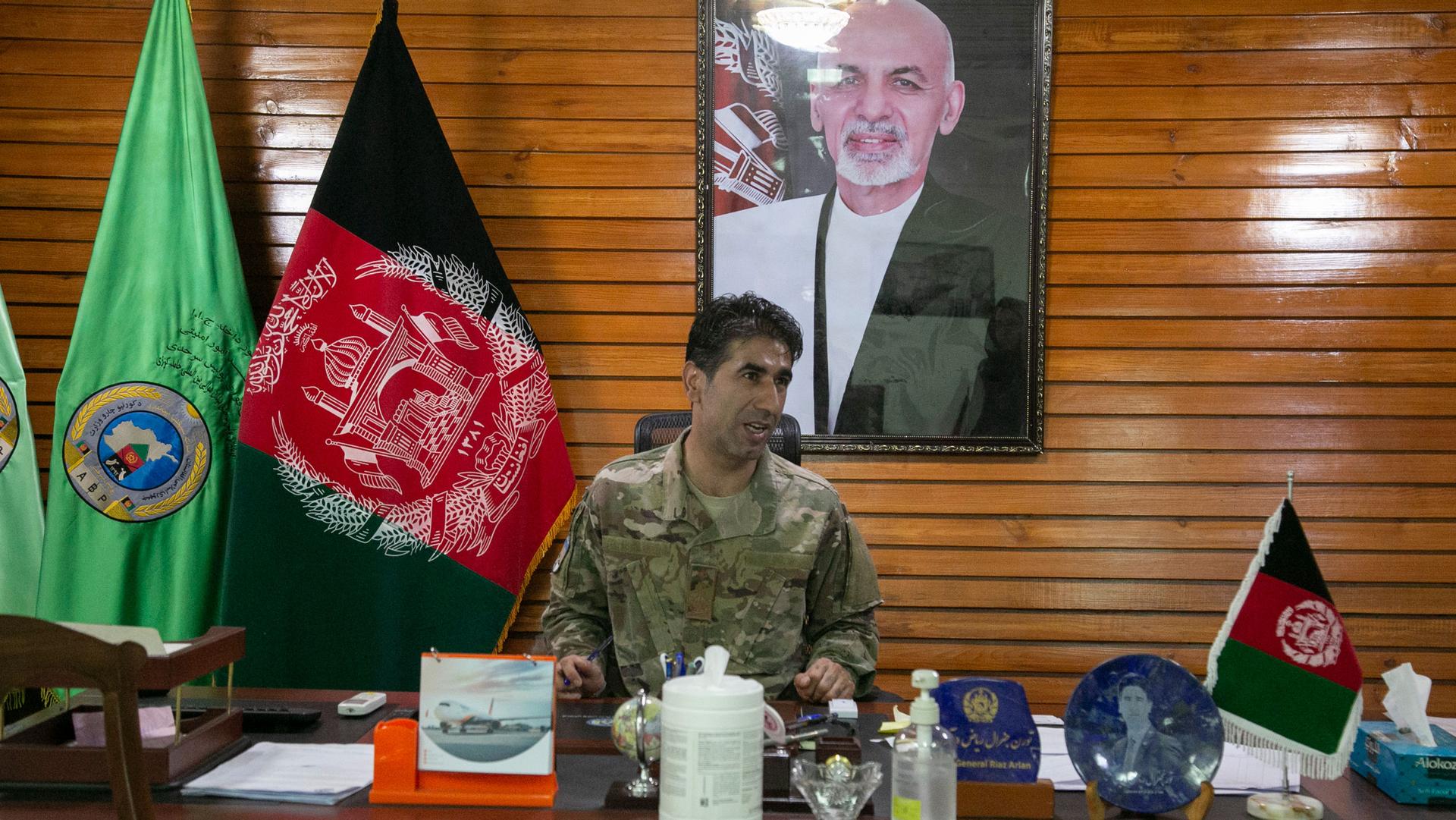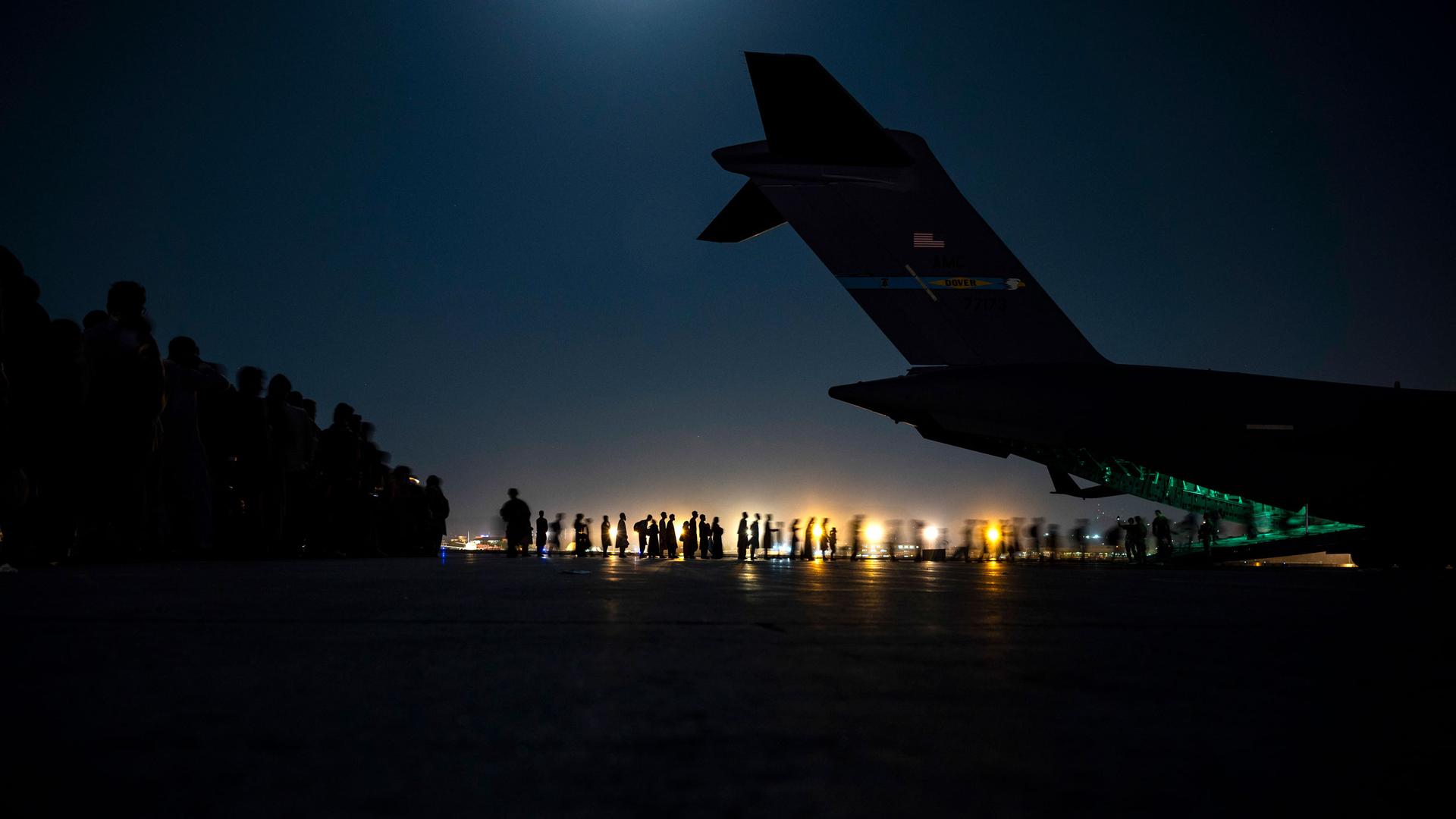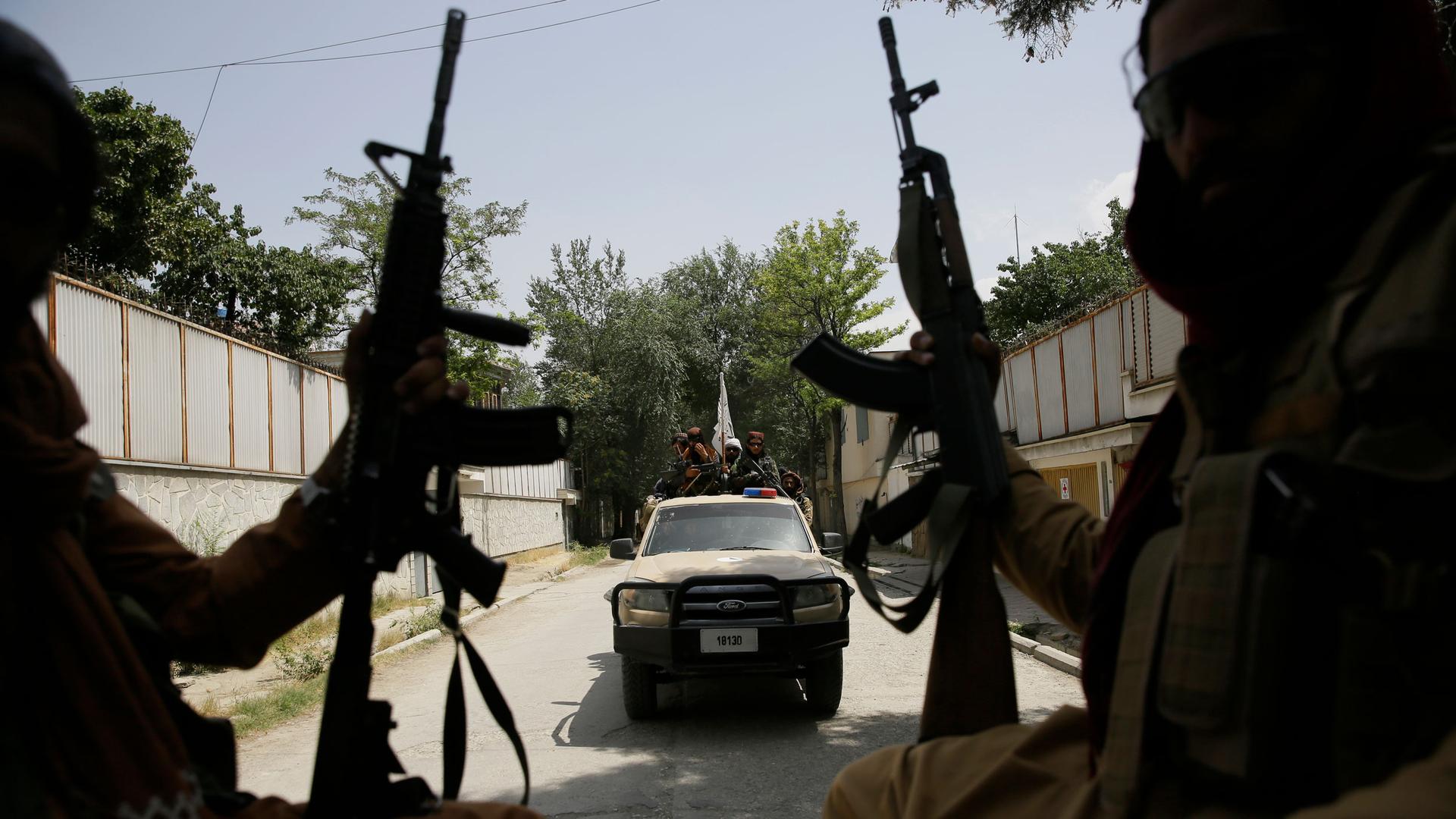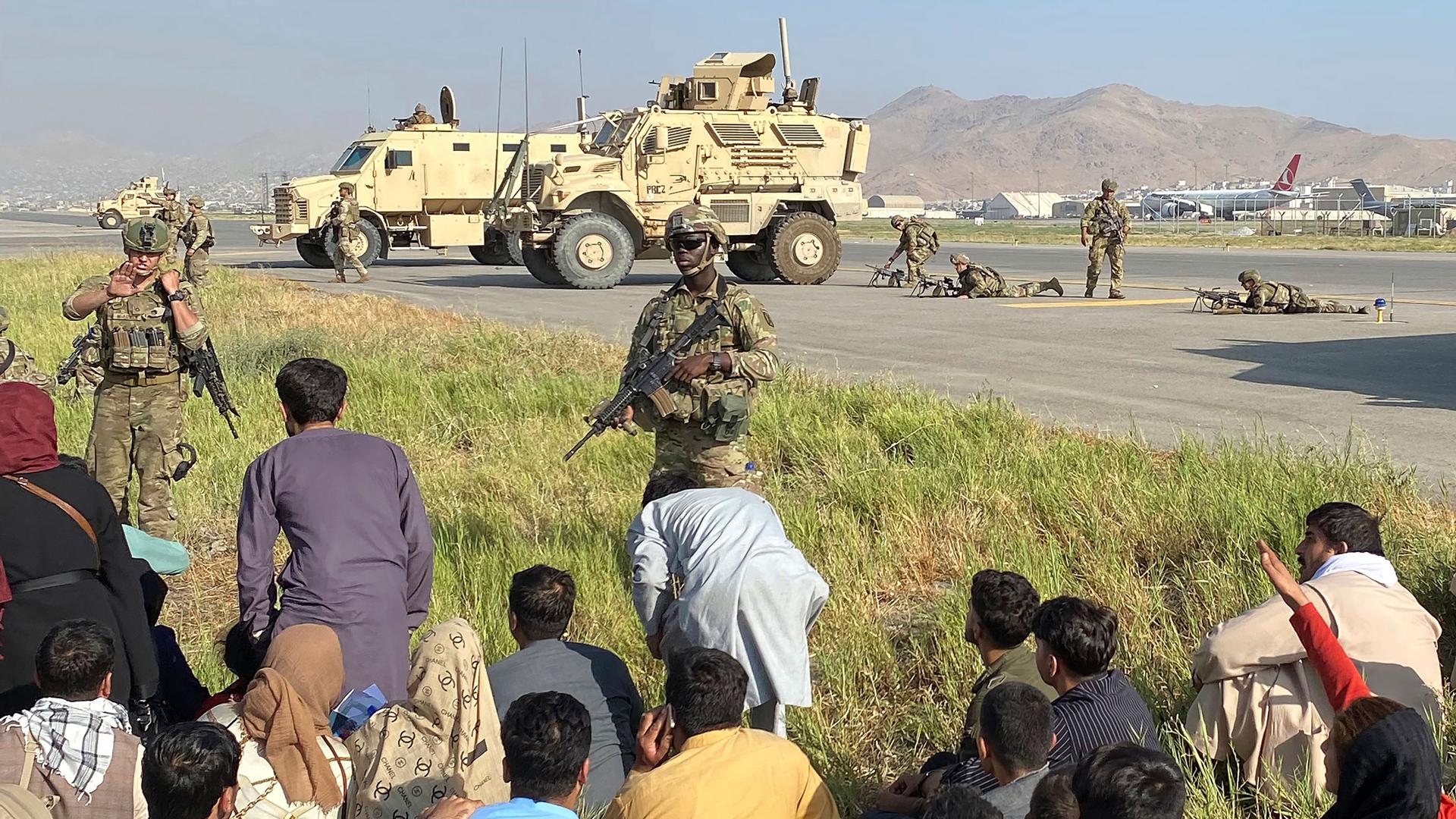Maj. Gen. Mohammad Reyaz Arian was the top commander in charge of security at the Hamid Karzai International Airport — one of the most important locations in the country — before the Afghan capital fell to the Taliban, a position he held for six months.
Before that, 45-year-old Arian served in the presidential protection service for Afghan presidents Hamid Karzai and Ashraf Ghani.
Related: This Afghan interpreter helped the US Army Special Forces. He’s desperate to get out of Afghanistan.
Arian, wearing his military uniform and sitting in front of a portrait of Ghani and a flag of Afghanistan projected confidence during an interview with The World at the airport in late July.
“You know, the security situation in our country, when you work in security, many things keep you awake at night. We are working to have tight security inside the airport.”
When asked if he was worried about airport security after US troops are fully withdrawn by the Aug. 31 deadline, he responded calmly, “You know the security situation in our country when you work in security, many things keep you awake at night. We are working to have tight security inside the airport.”
He added, “I don’t have any big concerns. Everything is under control.”

But within a matter of days, his confidence went by the wayside.
On Aug. 15, Taliban fighters poured into Kabul, leading to scenes of chaos and panic on the streets. President Ghani fled the country along with a few other top government officials. The airport was surrounded.
For many, Hamid Karzai International Airport became the only way to leave Afghanistan. Since then, the US and other countries have been working to evacuate people.
Those who’ve been able to land elsewhere say they are among the lucky ones — but they are concerned for those still in Afghanistan.
The US military reported its biggest day of evacuation flights out of Afghanistan by far on Monday, but deadly, persistent violence has blocked many desperate evacuees from entering Kabul’s airport, and the Taliban signaled they might soon seek to shut down the evacuation.

Twenty-eight US military flights ferried about 10,400 people to safety out of Taliban-held Afghanistan over the 24 hours that ended early Monday morning, a White House official said. The chief Pentagon spokesman, John Kirby, said the faster pace of evacuation was due, in part, to coordination with Taliban commanders on getting evacuees into the airport.
“Thus far, and going forward, it does require constant coordination and deconfliction with the Taliban,” Kirby said. “What we’ve seen is, this deconfliction has worked well in terms of allowing access and flow as well as reducing the overall size of the crowds just outside the airport.”
Since Aug. 14, the US has evacuated and facilitated the evacuation of about 37,000 people. The US military says it has the capacity to fly between 5,000 and 9,000 people out per day.
Kabul airport: A scene of chaos and tragedy
The US left all of its military bases in Afghanistan, including Bagram Airfield, its biggest in the country by early July.
As the Taliban swept through the country at lightning speed, other airports became difficult to access. Taliban fighters took major land border crossings and roads and highways between major cities became too dangerous to navigate.
Related: ‘If journalists leave a scene, it becomes a black hole,’ VOA journalist in Kabul says
Arian later told The World in a phone call that he and his staff stayed at the airport until 11 p.m. that night of Aug. 15. He then moved to a safe location within the city instead of going home because it was unsafe. But by the next day, he decided it was too dangerous for him to remain in the country. So, he left.
“One of my American friends at the airport helped me a lot,” he said from a location outside of Afghanistan. (The World is withholding his location for his safety).
“[I feel] not good. How can I feel good when everything became this bad?”
When asked how he is feeling right now, he said, “Not good. How can I feel good when everything became this bad?”
Shortly after the Afghan capital fell to the Taliban, scores of people rushed to the airport to leave.
Photos and videos shared on social media showed crowds scattered at the runway, dangerously close to planes taking off and landing.
One video showed a group of men clinging to a US military plane’s landing gear. The plane took off and the two men fell to their deaths. One of them was a young soccer player.
In another video, posted online Wednesday, a group of girls sang a beloved Afghan song about their homeland.
“Now, that I’ve lost you, my dear country,” they sang, “I’m forever burdened with sadness.”
The girls can’t be seen in the footage — only their long shadows, cast on the runway at Kabul’s only international airport.
‘I felt like I was going to die here’
Ramin Rahman, a 27-year-old photographer, made it out of the country last week. Rahman has worked for German news organizations for the past three years and said he has no doubt that he would have been a Taliban target had he stayed.
“I [have been] working with a lot of media, my face is there, I’ve written a lot of articles about a lot of things which made me feel that my life is in danger.”
“I [have been] working with a lot of media, my face is there, I’ve written a lot of articles about a lot of things which made me feel that my life is in danger,” he said.
On Monday morning, he got a call from one of his friends in Germany who told him to get to the airport immediately. His friend had put Rahman’s name on the list for an evacuation flight for German Embassy staff in Kabul. Rahman said he could only grab two things, his cellphone and laptop, before rushing to the airport. There, he saw utter chaos.
“A lot of people were panicking, they were running here and there, no police was there, no military, nothing,” he said.

Even worse, once he finally made it inside, there was no German flight.
Hours later, he got a call saying that the Germans would not start their evacuation until the next day. Rahman decided to sit tight at the airport. It was too risky to leave. The Taliban were on the streets outside and there were clashes at the entrance to the airport. Besides, he wasn’t sure if he’d be able to get back in if he left.
Hours passed. At around 11 p.m., he said, a US military plane landed. People rushed to get on board.
“It was such a difficult time for anyone. So many people were on the plane and so many people got wounded, got injured, people stepped on each other, a lot of women were crying, kids were crying, it was a horrible moment, I don’t want to remember it. Never,” he said.
At first, the Americans said the plane couldn’t take off. There were too many people on board. Some had to get off. Rahman started to make his way out but suddenly, the sound of gunfire came closer. The Americans told him to stay inside the plane. Rahman couldn’t see outside of the plane because the passenger side of the plane didn’t have any windows — but he could hear the gunfire.
“Then I feel hopeless. [I thought] OK, I’m going to die here now,” he said.
An hour and 20 minutes later, the plane started moving. He finally felt a sense of relief. His fellow passengers were ecstatic.
“They were cheering, they were clapping, they were happy that the plane just took off,” he recalled.
Rahman is now staying at a military base in the Gulf country of Qatar where thousands have been evacuated from Afghanistan. He said he is glad he made it out alive, but his parents and five siblings are still in Afghanistan — and he hopes to get them out soon.
The Associated Press contributed to this report.
